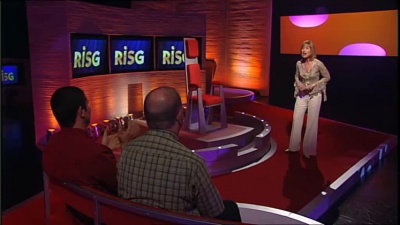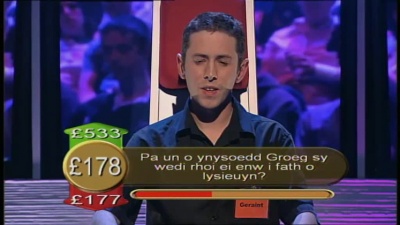Risg
Contents |
Host
Broadcast
Mentorn for S4C, 29 October 2004 to 6 January 2006 (59 episodes in 1 series)
Synopsis
"The players take risks. The audience takes risks. In fact everyone takes risks on Risg!".
And with that statement from the voiceover (never credited), plus the sight of the 50 audience members placing one pound coin each into a perspex box before taking their seats, the show begins. This show was devised so that the audience would play an active part in the show, and could share any winnings coming their way, but they are well aware of the risks involved in this show.
Siân comes on and asks the audience to watch a video screen, where the three players introduce themselves. After this, those three players come on stage and sit at a waiting area to the side of the arena. Siân now asks the audience to vote on the players on consoles with three buttons – thus deciding the order that the three can play. The player getting the most votes goes first, sits on the titular Cadair Aur (gold chair), which is on a turntable. Once the player is seated, it is spun gently half a turn, so that the player has his/her back to the audience, and a large board behind the player ensures the audience cannot see the player. Siân starts the game with £50, plus the fifty one pound coins from the audience's entry fee, making £100.
For each question, Siân asks that question, but before the player can answer it, the audience is asked to predict if the player will give a correct answer and register their opinion on ‘Yes’ or ‘No’ buttons on their voting console. The percentage of the audience who said ‘Yes’ decides the percentage of the pot ‘at risk’ for the question and the on-screen graphic shows this value, plus the new pot levels for a correct or incorrect answer. The player gives their answer. If correct, the pot is increased by the level ‘at risk’. If incorrect, the pot decreases by the same amount. A nice touch in the graphics replaces the question with its answer, but with a green background for a correct answer, or a red background for an incorrect answer.
To give an example, if the pot was at £200, and the vote for a question went 60%, a correct answer would add 60%, which is £120, to the pot making £320 for the next question. An incorrect answer lost that £120 leaving just £80 for the next question. If the pot got too low, in the early runs, after the pot was sent below £50, another £50 was added to the pot. In later runs, the pot was ‘floored’ at £50 and not allowed to fall below this – a £50 pot followed by an incorrect answer lost no money.
There were always two elements in each show. The first was a phone-in competition. Siân asks the question, the audience votes, then Siân calls a time-out and says that that question will go to the viewers. The viewers were given an 090 number (at 25p per call) and the length of the commercial break (around four minutes) to phone in with what was thought to be the answer (and there were no multiple choice options either.) When the break finished, Siân announces the phone lines closed, then the player gave their answer. After confirmation, Siân told the viewers that ten ‘winners’ would be chosen, whose names appeared at the end of the show, along with their prize (of which more anon.)
The second element was the third button on the audience’s voting console. While the first two buttons gave ‘Yes’ or ‘No’ responses to the question, the third button was ‘Risg’. If a player was doing badly, audience members would press this third button. This added a notch to a ‘Risg-o-meter’, which appeared on the screen as a thin bar below the question – but the audience did not see this meter. When more than half the audience had the ‘Risg’ button depressed, this filled out the ‘Risg-o-meter’, sounding a klaxon and the player would be ejected from the hot seat. The game continued with the second most popular player from the opening vote taking over the hot seat and spun into position. If the audience didn’t like this second player, a klaxon would eject that player and the third player would take over. Another kalxon meant the first player got another go, and so on. This carried its own risk - for each ejection, the pot was halved.
Whichever of the three players was on the hot seat when time ran out ‘won’ the game and earned the right to play for the money in the pot when time was called. That player was offered a choice: ‘Risg neu Rhannu’ and the gentle spin to face the audience was used as thinking time. Once the decision was made, the player was asked one further question, but facing the audience this time.
Imagine a pot of exactly £1000 being played for at this point. If the player went for ‘Risg’, the whole pot was up for grabs. If the player gave a correct answer, the player took £1000 and the audience would leave with nothing (although Siân remarked ‘At least you paid a pound each to watch this!’) If the player gave an incorrect answer, the player won nothing, while the audience claimed the £1000 for themselves, divided equally among the 50 members getting £20 each.
If the player chose ‘Rhannu’ (which means ‘share’), a correct answer meant the player took half the pot (£500) and the audience would share the other half (£500 divide by 50 makes £10 each). An incorrect answer meant the £1000 was split 51 ways (£19.60 each), one share to the winning player, and one share to each audience member.
But what about the viewers? The ten winning viewers received a Risg t-shirt, plus one audience members’ share of the prize money. However, if the audience won no money, the viewers won no money either.
Catchphrases
"And remember, never take any risks without me!" – Siân’s signoff at the end of every show.
Inventor
Trivia
The pot was top-limited at £20,000, but no game got anywhere near this figure.
The title means Risk.
Recorded at Studio 1 (HTV Wales), Culverhouse Cross, Cardiff.




